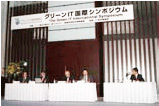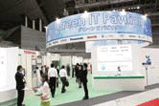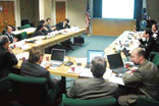Activities
Activities in FY2009
1.Role of the Diffusion Education Committee
Contributes to energy conservation and CO2 emissions reductionby (a) embedding green IT activities across society toward achieving both environmental conservation and economicgrowth, and (b) publicizing firms’ outstanding environmentaltechnologies at home and offshore to promote the utilization of products and technologies with high energy efficiency. Alsowidely communicates the results achieved by the Technology Study and Survey and Evaluation Committees to encourage thedevelopment of future guidelines on global warming and effortscurrently required.
2.Role of the Technology Study Committee
Identifies IT energy-saving technologies and creates roadmaps,drawing on these in considerations toward the advance and
expansion of green IT technologies.
《Energy-saving Technology Development Roadmap evaluation and utilization》
In early FY2009, the committee will engage in a comprehensive evaluation and review of the results of investigations by the FY2008 Technology Study Committee and the Survey and Evaluation Committee, etc., as well as follow-up studies, looking toward the strategic utilization of the Roadmap.
3.Role of the Survey and Evaluation Committee
Quantifies energy-saving in IT devices and in the various areas of society through IT toward a low-carbon society. To this end, the committee aims to establish green IT evaluation tools (benchmarks) to make visible the impact of green IT in terms of energy-saving and the contribution to CO2 reduction.Also examines green IT policies and initiatives offshore to identify the current status of initiatives and investigations around the world toward the international dissemination of green IT achievements.
Activities in FY2008
Conclusion of MOUs with offshore groups
To expand green IT activities globally, the Green IT Promotion Council concluded memoranda of understanding (MOUs) with US groups The Green Grid and the Climate Savers Computing Initiative in May 2008 and with the Korea Green Business IT Association in January 2009, laying the foundations for strengthening international partnerships.
Diffusion Education

Green IT International Symposium
We held the Green IT International Symposium in Tokyo in May 2008,comprising speeches and discussion by representatives from the government, research institutes and Japanese and foreign companies on green IT initiatives and expectations.
G8 Hokkaido Toyako Summit
exhibition assistance and the Green IT Pavilion
At the G8 Hokkaido Toyako Summit in July 2008, the Green IT Promotion Council assisted in organizing the Environmental Showcase and Zero Emission House exhibitions and also operated the Green IT Pavilion at the International Media Center, introducing company initiatives.
Green IT Awards 2008
The Green IT Promotion Council created the Green IT Awards with the cooperation of the Ministry of Economy, Trade and Industry,
presenting these for outstanding IT products, solutions and services.

CEATEC JAPAN 2008 Green IT Pavilion
At CEATEC JAPAN 2008, we introduced companies’ latest products and Green IT Award winners.
Technology Studies
Energy-saving of IT: Creation of a technology roadmap for IT and electronics
We are developing a roadmap on energy-saving up to 2025 that covers key IT devices (servers, storage devices, displays, computers, routers) for which power consumption is expected to soar in line with the coming information explosion, as well as the semiconductors underpinning these devices.Another such roadmap is being developed for those devices which are said to consume around 70 percent of household power (air conditioners, refrigerators, lighting and televisions), as well as the record and replay devices (DVDs, etc.) which are expected to take hold in the market over the coming years.
Energy-saving by IT: Studies on energy-saving in society
The concept of virtual mobility emerged in FY2007 from the work of the Technology Policy Working Group, which operates under the Technology Strategy Committee within the Japan Electronics and Information Technology Industries Association (JEITA), one of the Green IT Promotion Council’s founders. We undertook a study on virtual mobility for people and things as an issue that needs to be further advanced and developed,highlighting key cases and promising technologies.In the area of energy management systems, in addition to the Home Energy Management System (HEMS) and the Building Energy Management System (BEMS), we also looked at Enterprise EMS and Social EMS with a view to total optimization, putting together technology development recommendations.
Surveys and Evaluations

Workshop " Data Centers energy -
Saving indicators" with US and EU
1.Measuring and forecasting energy-saving of IT devices
We developed benchmarks for comparing the energy efficiency of 10 IT devices. Using this method and dissemination rates for the various devices, we also forecast the energy consumption and reduction effect by 2025 and by 2050.
2.Creating energy-saving indicators and forecasting energy-saving effects for data centers
We drew up forecasts on the future energy consumption and reduction effect of data centers based on expected server dissemination numbers, etc, with final adjustments reflecting Technology Study Committee results. We considered new indices for evaluating the
energy-saving performance of data centers.
3.Measuring and forecasting energy-saving by IT
We considered IT solution categories (industry, office, home, transportation, etc.) and elements for evaluating the CO2 reduction effect where various types of solutions were introduced, developing an effect calculation formula for each type of solution. Based on this formula, we considered examples of evaluations of the amount contributed to energy-saving by IT.
4.Considering methods of evaluating firms’ environmental contribution
We looked at methods for quantitatively evaluating the amount which companies developing and supplying green IT have contributed to CO2 reduction of and by IT. In FY2008, we examined basic methodologies for making visible the degree of contribution across the entire supply chain,identifying challenges and means of utilization.
5.Surveying offshore policies, etc.
In our FY2008 survey, we focused on the US and the EU, examining key initiatives, both government- and private-sector-led, in these regions.






